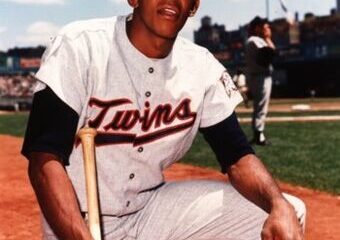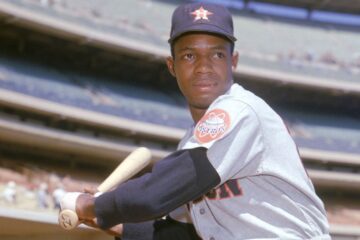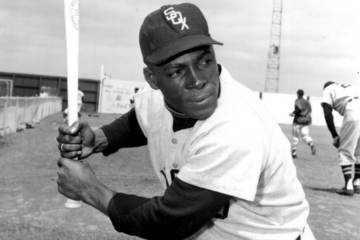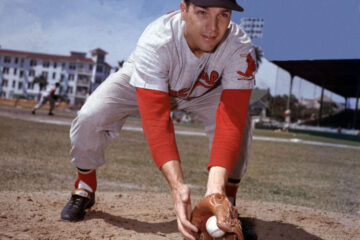The Hall of Fame Index: Albert Pujols
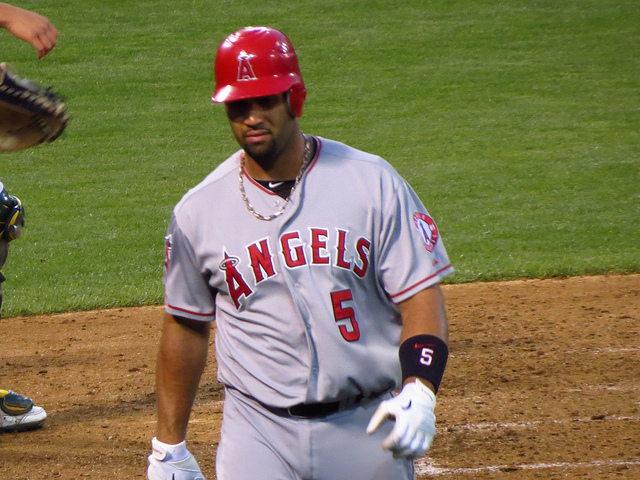
About five years ago there was an ad that MLB was running about the great players in the game. The general idea was, “remember the time when you saw Player A do this?” The commercial continued until it reached its epic conclusion, “do you remember the time when you saw Albert Pujols do everything?” The implication was pretty clear. At that time, Pujols would have been an unanimous choice for the best player in baseball. In fact, it wouldn’t have been that close.
At the time I wrote The Hall of Fame Index, Pujols wasn’t quite eligible to be considered, but right after the release of the book he finished his tenth season in the big leagues. Even back then, he was already a top five all-time first baseman. So, there is little drama behind whether he will be good enough to get in. The main question from here will be whether he will overtake Lou Gehrig for the top spot.
As a gentle reminder, the Hall of Fame Index is made up of WAR scores from Baseball Reference, Baseball Prospectus, and Fangraphs. We take a career value total (which Pujols is obviously still working on) and a peak value total based on each player’s top ten seasons. Those days have come and gone for Pujols.
Career Value
| BR | BP | FG | Total | |
| Lou Gehrig | 112.4 | 114.4 | 116.3 | 343.1 |
| Jimmie Foxx | 96.4 | 99.1 | 101.8 | 297.3 |
| Frank Thomas | 73.7 | 73.1 | 72.0 | 218.8 |
| Eddie Murray | 68.3 | 65.1 | 72.0 | 205.4 |
| Willie McCovey | 64.4 | 62.3 | 67.4 | 194.1 |
| Harmon Killebrew | 60.3 | 65.0 | 66.1 | 191.4 |
| Hank Greenberg | 57.5 | 59.3 | 61.1 | 177.9 |
| Bill Terry | 54.2 | 55.6 | 57.0 | 166.8 |
| Tony Perez | 53.9 | 47.7 | 58.9 | 160.5 |
| George Sisler | 54.5 | 53.2 | 51.9 | 159.6 |
| Albert Pujols | 99.8 | 110.1 | 90.6 | 300.5 |
One of the great things about writing multiple articles about first basemen (see also: David Ortiz) is that it allows me to jump back into discussion points we just left. If you read that other piece, you know I question the qualifications of not only Ortiz, but also Tony Perez. I might have been overly harsh on Perez. After all, he is legitimately a borderline Hall of Famer. My difficulty comes not necessarily in the fact that people argue for him, but those arguments they choose to take.
Usually, arguments in those cases either center on the fact that he had the most RBI for any player sitting out of the Hall of Fame at the time of his selection. I don’t have to tell you that like a stopped clock being right twice a day, someone will always have that distinction. The other one centers on the idea that he was somehow the glue that kept that team together. I’m calling shenanigans on that. The Big Red Machine arguably became the Big Red Machine when the Houston Astros traded Joe Morgan to the Reds for a sack of magic beans. Perez was quite clearly the fourth best Red throughout that five year stretch. That doesn’t mean he isn’t a Hall of Famer, but the glue that held the team together is laying it on a bit thick.
As for Pujols, the career index may say he trails by more than 40 wins, but we have to remember that those wins come in multiples of three. So, he is really around 15 wins short. From here, it depends on how much longer Pujols wants to play. He has five more seasons on his contract, but I seriously doubt he will finish out his contract. At his current rate of production it seems unlikely he will get there.
Peak Value
| BR | BP | FG | Total | |
| Lou Gehrig | 90.1 | 91.4 | 92.7 | 274.2 |
| Jimmie Foxx | 73.7 | 75.7 | 77.7 | 227.1 |
| Frank Thomas | 56.2 | 55.7 | 57.3 | 169.2 |
| Hank Greenberg | 51.5 | 53.3 | 55.1 | 154.9 |
| Bill Terry | 50.4 | 51.6 | 52.8 | 154.8 |
| George Sisler | 50.7 | 49.9 | 49.0 | 149.6 |
| Willie McCovey | 49.3 | 49.3 | 49.6 | 148.2 |
| Harmon Killebrew | 45.8 | 49.0 | 49.0 | 143.8 |
| Eddie Murray | 46.4 | 47.6 | 49.3 | 143.3 |
| Tony Perez | 44.6 | 40.0 | 48.1 | 132.7 |
| Albert Pujols | 81.1 | 92.0 | 77.4 | 250.5 |
The numbers we see above point to two very important points. First, it shows just how dominant a player Pujols was when he came up. We really should emphasize that word “player.” Some would say he was a dominant hitter or a dominant offensive player, but he really was a dominant all-around player. The second point is that as good as Pujols was, Lou Gehrig was that much better. We often don’t give Gehrig his due because he played with Babe Ruth, but he was legitimately the second best player in the league for most of his time with the Yankees.
The peak value component ended up being very important for those on the bottom of the list. In particular, Sisler and Terry recovered from lackluster career values to comfortably finish above 300 in the total index. Both players hit over .400 in their careers with Sisler putting up perhaps a couple of the best seasons in history. Those tend to contribute to the “fame” component of the discussion.
We can continue to pick on Perez, but one of the things we look at is where a player finishes in the MVP voting during his prime. He had one third place voting in 1970 and never finished in the top five again. Just as a comparison, Pujols won the award three times, was the runner up four times, and finished in the top five in every season through 2011 except for one. He led the league in WAR four times and finished second three times. Clearly, Pujols was the best player in the game during his peak. Perez wasn’t the best player on his side of the infield.
The Hall of Fame Index
| Career | Peak | Total | |
| Lou Gehrig | 343.1 | 274.2 | 617.1 |
| Jimmie Foxx | 297.3 | 227.1 | 524.4 |
| Frank Thomas | 218.8 | 169.2 | 388.0 |
| Eddie Murray | 205.4 | 143.3 | 348.7 |
| Willie McCovey | 194.1 | 148.2 | 342.3 |
| Hank Greenberg | 177.9 | 159.9 | 337.8 |
| Harmon Killebrew | 191.4 | 143.8 | 335.2 |
| Bill Terry | 166.8 | 154.8 | 321.6 |
| George Sisler | 159.6 | 149.6 | 309.2 |
| Tony Perez | 160.5 | 132.7 | 293.2 |
| Albert Pujols | 300.5 | 250.5 | 551.0 |
Angels fans may have a lot to be upset about. Their team is near the cellar in the AL West and their farm system is essentially barren, but they have the best player in baseball from the last decade on their squad and the current best player in baseball on the same team. It’s sometimes hard to appreciate what you have until it’s gone. Pujols may not be the player he once was, but he shows glimpses of that brilliance that made him a man among boys.
As for the rest, the group demonstrate that the BBWAA generally does a good job of selecting players. As hard a time as I’ve given them on Perez, his selection wasn’t completely horrible. The best thing about baseball’s Hall of Fame is the amount of debate it’s selection process creates. You don’t get that in any other sport.


